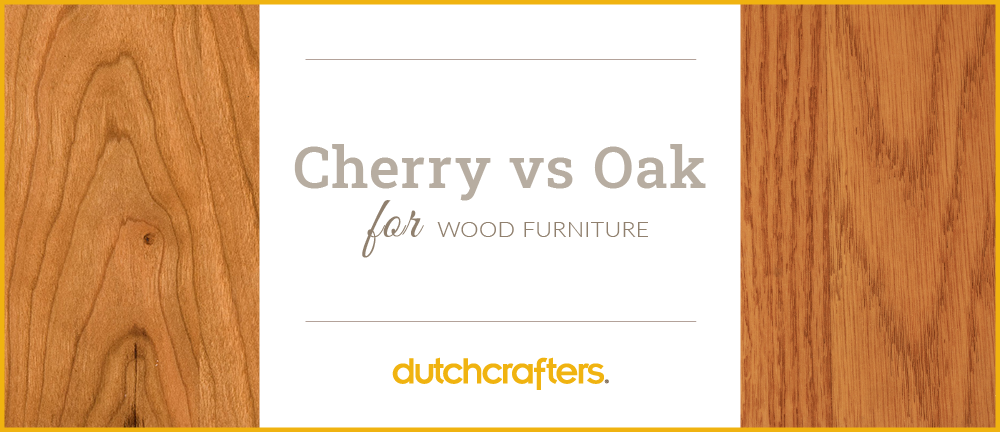If you’ve ever wondered, “Is cherry wood strong?” then you’re in the right place! Cherry wood is known for its beauty and rich reddish hue, but what about its durability? In this article, we’ll explore the strength of cherry wood and discover why it’s a popular choice for furniture and other woodworking projects. So let’s dive in and find out if cherry wood lives up to its reputation!
When it comes to measuring strength, cherry wood holds its own. Despite being a relatively softer hardwood compared to oak or maple, cherry wood still boasts impressive qualities. Its tight grain pattern and dense composition contribute to its overall strength, making it a reliable and sturdy material. So if you’re considering cherry wood for your next project, you can rest assured that it can handle everyday use without a problem.
But strength alone doesn’t tell the whole story. Cherry wood also excels in terms of versatility and aesthetics. Its natural beauty, with its warm tones and occasional dark streaks, adds a touch of elegance to any space. Whether you’re crafting a dining table, a bed frame, or even a musical instrument, cherry wood’s strength and visual appeal make it a top choice for woodworking enthusiasts. So, if you want a durable and stunning material, cherry wood might just be the perfect fit for your next project.
In conclusion, cherry wood is indeed strong and can withstand the test of time. Its combination of strength, beauty, and versatility makes it a popular choice among woodworkers and furniture makers alike. So, whether you’re a DIY enthusiast or a professional woodworker, consider using cherry wood for your next project and enjoy the stunning results it can bring to your creations!

Is Cherry Wood Strong?
Cherry wood is a popular choice for furniture and woodworking projects due to its beautiful grain and rich color. But is cherry wood strong enough to stand the test of time? In this article, we will explore the strength and durability of cherry wood, examining its properties, uses, and advantages.
The Strength of Cherry Wood
Cherry wood is often considered to be a moderately strong hardwood. It has a Janka hardness rating of around 950, which means it is harder than some other common hardwoods like oak and maple. This hardness gives cherry wood good resistance to dents and damage.
Cherry wood also has good bending and compression strength, making it suitable for a range of applications. It can be carved, turned, and machined with ease, making it a favorite among woodworkers. However, it is important to note that cherry wood is not as strong as some tropical hardwoods or softwoods like pine.
Despite its moderate strength, cherry wood is highly prized for its beauty and character. Its warm reddish-brown color and distinct grain patterns add a touch of elegance to any piece of furniture or woodworking project.
The Durability of Cherry Wood
While cherry wood may not be the strongest hardwood out there, it is still considered to be durable and long-lasting. When properly maintained and cared for, cherry wood furniture can last for generations. Its natural oils help protect it from moisture and insect damage, enhancing its longevity.
One factor to consider is that cherry wood is susceptible to sunlight, which can cause it to darken over time. However, this is often seen as a desirable characteristic, adding depth and richness to the wood’s color. To minimize darkening, it is recommended to keep cherry wood furniture away from direct sunlight and to use UV-protective coatings.
In terms of structural durability, cherry wood is known to be stable and resistant to warping and shrinking. This makes it a reliable choice for furniture and cabinetry, where stability is crucial.
Uses of Cherry Wood
Cherry wood has a wide range of uses in the woodworking industry. Its strength, durability, and beautiful appearance make it suitable for various applications.
One of the most common uses of cherry wood is for furniture, including dining tables, chairs, and cabinets. Its warm color and grain pattern make it particularly popular for creating elegant, timeless pieces. Cherry wood is also utilized in interior trim, flooring, and paneling.
Woodworkers often choose cherry wood for its workability and versatility. It can be easily cut, carved, and shaped, making it ideal for intricate designs and fine detailing. Cherry wood is also used for turning projects, such as bowls, vases, and spindles.
Cherry Wood vs. Other Hardwoods
When it comes to comparing cherry wood to other hardwoods, such as oak or maple, there are a few key differences to consider.
Strength and Durability
Compared to oak and maple, cherry wood falls in the middle in terms of strength. While it is not as strong as oak, it still offers good durability and resistance to wear and tear. Cherry wood is also less prone to splitting or splintering than oak.
Appearance
Cherry wood has a distinct reddish-brown color that deepens with age. In comparison, oak has a lighter, golden-brown hue, while maple tends to have a pale, creamy color. The unique grain patterns of cherry wood give it a rich and luxurious appearance that many find appealing.
Workability
Cherry wood is known for its excellent workability, making it a favorite among woodworkers. It can be easily machined, carved, and polished to achieve intricate designs and smooth finishes. Oak, on the other hand, can be more challenging to work with due to its hardness and density.
Maintaining Cherry Wood
To ensure that your cherry wood furniture stays strong and beautiful, it is important to take proper care of it. Here are a few tips for maintaining cherry wood:
- Regularly dust and clean your cherry wood furniture with a soft cloth or duster.
- Avoid exposing cherry wood to direct sunlight, as this can cause the wood to darken.
- Use coasters or placemats to protect the surface of cherry wood tables from heat, moisture, and spills.
- Apply a high-quality wood polish or wax to enhance the natural luster of the cherry wood.
- Inspect your furniture periodically for any signs of damage or wear and address them promptly to prevent further issues.
By following these simple maintenance practices, you can ensure that your cherry wood furniture remains strong and beautiful for years to come.
Key Takeaways – Is Cherry Wood Strong?
- Cherry wood is known for its strength and durability.
- It is a hardwood, which means it is resistant to wear and tear.
- Cherry wood has a tight grain structure, making it less prone to warping or splitting.
- Although it is strong, cherry wood can still be susceptible to scratches and dents, so care should be taken.
- Cherry wood is a popular choice for furniture and cabinetry due to its strength and beautiful reddish-brown color.
Frequently Asked Questions
Curious about the strength of cherry wood? Look no further! Here are some commonly asked questions and answers about the strength of cherry wood.
1. How does cherry wood compare to other types of wood in terms of strength?
Cherry wood is considered to be a moderately strong wood. While it may not be as strong as some hardwoods like oak or maple, it still possesses good structural integrity. Cherry wood has a Janka hardness rating of around 950, which means it can withstand moderate wear and tear. It is often used in furniture making due to its durability and aesthetic appeal.
However, it’s important to note that the strength of cherry wood can vary depending on the specific tree it comes from, as well as the way it is processed and treated. Overall, cherry wood is a reliable choice for various woodworking projects.
2. Is cherry wood prone to warping or splitting?
Like most types of wood, cherry wood can be susceptible to warping or splitting under certain conditions. However, when properly dried and seasoned, cherry wood is more stable compared to some other woods. It is important to allow the wood to acclimate to the environment in which it will be used before starting a project, as this can help minimize the risk of warping or splitting.
To prevent warping or splitting, it’s also essential to seal and finish the wood properly. Applying a protective finish can help reduce the wood’s exposure to moisture, which is often the main culprit behind these issues. Regular maintenance, such as keeping the wood away from excessive heat or moisture, can further help prolong the lifespan and maintain the strength of cherry wood.
3. Can cherry wood handle heavy loads or weight?
While cherry wood is not the strongest wood available, it is still capable of handling significant weight and heavy loads. Its moderate strength and durability make it suitable for many furniture applications, such as tables, chairs, and cabinets. When used in structural elements, cherry wood can provide sufficient support, but it is always important to follow appropriate design and construction guidelines specific to the project.
For extra reinforcement, cherry wood can be combined with other construction methods or materials. For example, using sturdy joinery techniques, such as dovetail or mortise and tenon joints, can enhance the overall strength and stability of cherry wood furniture.
4. How does the age of cherry wood affect its strength?
The age of cherry wood can impact its strength to a certain extent. Generally, older cherry trees tend to have denser wood, which can result in increased strength. However, the overall strength also depends on other factors like the growth conditions of the tree, the part of the tree the wood is obtained from, and the way it is processed. Therefore, it’s important to consider various factors when assessing the strength of cherry wood.
Furthermore, proper drying and curing of cherry wood after harvesting can significantly affect its strength. Adequate air circulation and time for moisture evaporation are essential for producing strong and stable cherry wood. Careful handling and treatment throughout the woodworking process also play vital roles in preserving and maximizing the strength of cherry wood.
5. Can cherry wood be used for outdoor projects?
Cherry wood is not typically recommended for outdoor projects, as it is not naturally resistant to weather and moisture. Exposure to outdoor elements can lead to warping, rotting, and decay. However, if properly treated with a protective finish and regularly maintained, cherry wood can be suitable for certain outdoor applications that are not directly exposed to harsh conditions.
For example, cherry wood may be used for covered outdoor structures or decorative elements that are shielded from direct rainfall and excessive moisture. Applying a high-quality exterior wood finish can help enhance its resistance to water damage. Nevertheless, it is generally recommended to choose wood species like teak or cedar, which have natural resistance to outdoor conditions, for long-lasting outdoor projects.

Summary
Cherry wood is a strong and durable material that is often used in furniture and woodworking projects. It has a tight grain pattern and high density, making it resistant to wear and tear. While it may not be as strong as some other hardwoods, it is still a reliable and long-lasting choice for many applications. However, it’s important to note that the strength of cherry wood can vary depending on factors such as the way it is processed and how it is used.
In conclusion, cherry wood is a solid option for furniture and woodworking projects. Its strength and durability make it a reliable choice, although its level of strength can vary. So, whether you’re building a new table or crafting a beautiful cabinet, cherry wood can be a great choice to consider.
source https://thehabitofwoodworking.com/2023/is-cherry-wood-strong/

No comments:
Post a Comment